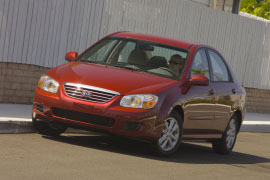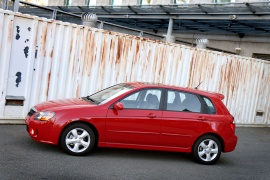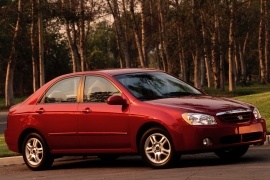KIA Cerato / Spectra Models/Series Timeline, Specifications & Photos
First production year: 2004
Engines: Diesel, Gasoline
Kia introduced the first generation of the Cerato/Spectra in 2004 on the same platform as the Hyundai Elantra. Just three years later, the Korean carmaker refreshed the lineup.
It was designed mostly as a commuter car, with enough interior room, a decent-sized trunk, and not too many amenities to enhance the driver on long journeys. But, even on the base trim level, it featured air-conditioning, front power windows, and a stereo. For a budget vehicle with good fuel-efficiency, it was an excellent choice.
Since the new-edge design trend was closing to an end, Kia tried to enhance the car's look with softer lines. But it couldn't save the bland look of the vehicle nor the initial lines that defined the car. The headlights featured rounded corners and bigger turn-signals. The car's front bumper was reshaped and featured a wider center grille and two side-scoops. Unlike its predecessor, the grille was chromed. The taillights were redesigned in the rear, and the reversing light's area was installed on the bottom instead of the middle height.
Inside, the Spectra retained the same values that made it a good buy for most of its customers. It didn't enhance the materials used, which proved to be very reliable. Its plastic molded dashboard and center stack were just carried over from the non-facelifted version.
Under the hood, Kia shrunk the engine choice from six to two engines. It kept only the most powerful gasoline engine and, for the European market, the newly developed 1.6-liter turbodiesel unit.
The five-doors Cerato/Spectra received a mid-life cycle refresh in 2007, three years after the carmaker introduced it to the market.
While Kia was still struggling to find its design language and Peter Schreyer was new in the company, the carmaker couldn't afford to stop the production of the Cerato/Spectra 5 hatchback. It had to improve it and make it better, even if its career was very close to an end and the cee'd lineup was ready to wow the crowds. After all, the car proved to be a dependable companion, offering good fuel-efficiency and adequate comfort for a daily driven commuter car.
Since the new-edge design trend was closing to an end, Kia tried to enhance the car's look with softer lines. But it couldn't save the bland look of the vehicle nor the initial lines that defined the car. Its headlights featured rounded corners and bigger turn-signals. The car's front bumper was reshaped and featured a wider center grille and two side-scoops. Unlike its predecessor, the grille was chromed. In the back, the slightly raked-forward tailgate received a standard roof-spoiler above the windscreen.
Inside, Spectra retained the same values that made it a good buy for most of its customers. It didn't enhance the materials used, which proved to be very reliable. Its plastic molded dashboard and center stack were just carried over from the non-facelifted version.
Under the hood, Kia shrunk the engine choice from six to two engines. It kept only the most powerful gasoline engine and, for the European market, the newly developed 1.6-liter turbodiesel unit.
The second generation of the Cerato/Spectra sedan appeared in 2004, and Kia built it on top of the Hyundai Accent platform.
While Kia was little known in the world, the Korean carmaker continued its path and targeted the top-10 carmaker's list in the world, along with its partner Hyundai. The Cerato, or Spectra as it was known on several markets, followed a modern car concept designed to provide adequate performances and low running costs.
Maybe it wasn't the best-looking car in its class, but it wasn't on the bottom of the list either. Its curved lines combined in sharp or straight angles followed the new-edge design trends introduced by Ford on the market. The car's proportions were good, and it looked like the Koreans got it right this time. Maybe it was a bland design, but it wasn't bad anymore.
Inside, Kia took its inspiration from the 2003 Hyundai Accent with dual vents on the dashboard sides and another pair on the center stack. Like its sibling, it showed the speedometer in the middle of the instrument panel, flanked on the sides by the tachometer on the left and the fuel and temperature gauges on the right. It offered good access to the rear seats as a sedan, but just like the Accent, it provided little room for three passengers.
Under the hood, Kia installed a wide choice of gasoline or turbo-diesel engines, depending on the market.
In 2004, Kia launched the second generation for its compact hatchback Cerato, also known as Spectra 5 in the U.S.
While it didn't have a long life since it was replaced in 2008, the Cerato hatchback was an important step ahead for the Korean carmaker. An action required before the launch of one of the most important cars from its lineup, later on, the cee'd. It was built as an alternative for the pricier Civics.
There was a new design language for the Korean carmaker, but it didn't know exactly which one. It was a combination between the sharp lines of the headlights and the fluid ones on the sides plus a Nissan Almera hatchback inspired rear end, with a different shape for the taillights.
The interior was even more mesmerizing. It featured a clean and rounded dashboard design and an assorted instrument cluster, but then it was the center stack, which didn't look like it belonged there. It looked like it was dismantled from a bigger vehicle and just snapped into place. And if you'd turn it upside down, it looked like a sad robot.
For the drivetrain, Kia installed only one engine for the U.S. market and four for the European customers. It seems like the carmaker didn't know where it should be its primary market. All versions were paired to a 5-speed manual as standard, and the automatic transmissions were available just for the gasoline-powered versions. Fortunately, the cee'd come only in time four years later to save the brand's image. Not even the 2006 facelifted Cerato hatchback could keep the Korean compact vehicle.



